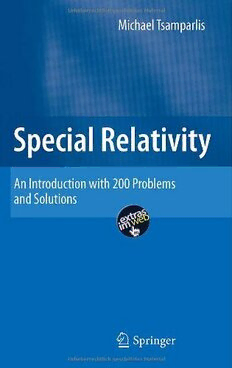Table Of ContentSpecial Relativity
Michael Tsamparlis
Special Relativity
An Introduction with 200 Problems
and Solutions
123
Dr.MichaelTsamparlis
DepartmentofAstrophysics,AstronomyandMechanics
UniversityofAthens
Panepistimiopolis
GR15784ZOGRAFOS
Athens
Greece
mtsampa@phys.uoa.gr
Additionalmaterialtothisbookcanbedownloadedfromhttp://extra.springer.com.
Password:978-3-642-03836-5
ISBN978-3-642-03836-5 e-ISBN978-3-642-03837-2
DOI10.1007/978-3-642-03837-2
SpringerHeidelbergDordrechtLondonNewYork
LibraryofCongressControlNumber:2009940408
(cid:2)c Springer-VerlagBerlinHeidelberg2010
Thisworkissubjecttocopyright.Allrightsarereserved,whetherthewholeorpartofthematerialis
concerned,specificallytherightsoftranslation,reprinting,reuseofillustrations,recitation,broadcasting,
reproductiononmicrofilmorinanyotherway,andstorageindatabanks.Duplicationofthispublication
orpartsthereofispermittedonlyundertheprovisionsoftheGermanCopyrightLawofSeptember9,
1965,initscurrentversion,andpermissionforusemustalwaysbeobtainedfromSpringer.Violations
areliabletoprosecutionundertheGermanCopyrightLaw.
Theuseofgeneraldescriptivenames,registerednames,trademarks,etc.inthispublicationdoesnot
imply,evenintheabsenceofaspecificstatement,thatsuchnamesareexemptfromtherelevantprotective
lawsandregulationsandthereforefreeforgeneraluse.
Coverdesign:eStudioCalamarS.L.
Printedonacid-freepaper
SpringerispartofSpringerScience+BusinessMedia(www.springer.com)
Omniameamecumfero
WhateverIpossessIbearwithme
Preface
WritinganewbookontheclassicsubjectofSpecialRelativity,onwhichnumerous
important physicists have contributed and many books have already been written,
canbelikeaddinganotherepicycletothePtolemaiccosmology.Furthermore,itis
our belief that if a book has no new elements, but simply repeats what is written
in the existing literature, perhaps with a different style, then this is not enough
to justify its publication. However, after having spent a number of years, both in
classandresearchwithrelativity,Ihavecometotheconclusionthatthereexistsa
place for a new book. Since it appears that somewhere along the way, mathemat-
ics may have obscured and prevailed to the degree that we tend to teach relativity
(andIbelieve,theoreticalphysics)simplyusing“heavier”mathematicswithoutthe
inspiration and the mastery of the classic physicists of the last century. Moreover
current trends encourage the application of techniques in producing quick results
and not tedious conceptual approaches resulting in long-lasting reasoning. On the
otherhand,physicscannotbedonea´ lacartestrippedfromphilosophy,or,toputit
inasimplebutdramaticcontext
Abuildingisnotanaccumulationofstones!
As a result of the above, a major aim in the writing of this book has been the
distinction between the mathematics of Minkowski space and the physics of rel-
ativity. This is necessary for one to understand the physics of the theory and not
staywiththegeometry,whichbyitselfisaveryelegantandattractivetool.There-
fore in the first chapter we develop the mathematics needed for the statement and
developmentofthetheory.Theapproachislimitedandconcisebutsufficientforthe
purposesitissupposedtoserve.Havingfinishedwiththemathematicalconceptswe
continue with the foundation of the physical theory. Chapter 2 sets the framework
on the scope and the structure of a theory of physics. We introduce the principle
ofrelativityandthecovariance principle,bothprinciplesbeingkeystonesinevery
theoryofphysics.SubsequentlyweapplythescenariofirsttoformulateNewtonian
Physics(Chap.3)andthenSpecialRelativity(Chap.4).TheformulationofNewto-
nianPhysicsisdoneinarelativisticway,inordertopreparethegroundforaproper
understandingoftheparallelformulationofSpecialRelativity.
Havingfoundedthetheorywecontinuewithitsapplication.Theapproachissys-
tematicinthesensethatwedevelopthetheorybymeansofastepwiseintroduction
vii
viii Preface
of new physical quantities. Special Relativity being a kinematic theory forces us
to consider as the fundamental quantity the position four-vector. This is done in
Chap.5wherewedefinetherelativisticmeasurementofthepositionfour-vectorby
means of the process of chronometry. To relate the theory with Newtonian reality,
weintroducerules,whichidentifyNewtonianspaceandNewtoniantimeinSpecial
Relativity.
In Chaps. 6 and 7 we introduce the remaining elements of kinematics, that is,
the four-velocity and the four-acceleration. We discuss the well-known relativistic
composition law for the three-velocities and show that it is equivalent to the Ein-
steinrelativityprinciple,thatis,theLorentztransformation.Inthechapteroffour-
accelerationweintroducetheconceptofsynchronizationwhichisakeyconceptin
therelativisticdescriptionofmotion.Finally,wediscussthephenomenonofaccel-
eration redshift which together with some other applications of four-acceleration
showsthatherethelimitsofSpecialRelativityarereachedandonemustgooverto
GeneralRelativity.
After the presentation of kinematics, in Chap. 8 we discuss various paradoxes,
whichplayanimportantroleinthephysicalunderstandingofthetheory.Wechoose
topresentparadoxeswhicharenotwellknown,asforexample,itisthetwinpara-
dox.
InChap.9weintroducethe(relativistic)massandthefour-momentumbymeans
ofwhichwedistinguishtheparticlesinmassiveparticlesandluxons(photons).
Chapter10isthemostusefulchapterofthisbook,becauseitconcernsrelativistic
reactions,wheretheuseofSpecialRelativityisindispensible.Thischaptercontains
manyexamplesinordertofamiliarizethestudentwithatool,thatwillbenecessary
toothermajorcoursessuchasparticlephysicsandhighenergyphysics.
InChap.11wecommencethedynamicsofSpecialRelativitybytheintroduction
of the four-force. We discuss many practical problems and use the tetrahedron of
Frenet–Serrettocomputethegenericformofthefour-force.Weshowhowthewell-
knownfour-forcescomplywiththegenericform.
In Chap. 12 we introduce the concept of covariant decomposition of a tensor
along a vector and give the basic results concerning the 1 + 3 decomposition in
Minkowski space. The mathematics of this chapter is necessary in order to under-
stand properly the relativistic physics. It is used extensively in General Relativity
but up to now we have not seen its explicit appearance in Special Relativity, even
thoughitisapowerfulandnaturaltoolbothforthetheoryandtheapplications.
Chapter13isthenextpillarofSpecialRelativity,thatis,electromagnetism.We
presentinaconcisewaythestandardvectorformofelectromagnetismandsubse-
quentlyweareledtothefourformalismformulationasanaturalconsequence.After
discussingthestandardmaterialonthesubject(four-potential,electromagneticfield
tensor,etc.)wecontinuewithlesserknownmaterial,suchasthetensorformulation
ofOhm’slawandthe1+3decompositionofMaxwell’sequations.Thereasonwhy
weintroducethesemoreadvancedtopicsisthatwewishtopreparethestudentfor
coursesonimportantsubjectssuchasrelativisticmagnetohydrodynamics(RMHD).
Therestofthebookconcernstopicswhich,toourknowledge,cannotbefound
intheexistingbooksonSpecialRelativityyet.InChap.14wediscusstheconcept
Preface ix
of spin as a natural result of the generalization of the angular momentum tensor
in Special Relativity. We follow a formal mathematical procedure, which reveals
what“thespinis”withouttheuseofthequantumfieldtheory.Asanapplication,we
discussthemotionofachargedparticlewithspininahomogeneouselectromagnetic
fieldandrecoverthewell-knownresultsintheliterature.
Chapter15dealswiththecovariantLorentztransformation,aformwhichisnot
widelyknown.AllfourtypesofLorentztransformationsareproducedincovariant
form and the results are applied to applications involving the geometry of three-
velocityspace,thecompositionofLorentztransformations,etc.
Finally,inChap.16westudythereaction A+B −→C+Dinafullycovariant
form.Theresultsaregenericandcanbeusedtodevelopsoftwarewhichwillsolve
suchreactionsdirectly,providedoneintroducestherightdata.
The book includes numerous exercises and solved problems, plenty of which
supplementthetheoryandcanbeusefultothereaderonmanyoccasions.Inaddi-
tion, a large number of problems, carefully classified in all topics accompany the
book.
The above does not cover all topics we would like to consider. One such topic
isrelativisticwaves,whichleadstotheintroductionofDeBrogliewavesandsub-
sequently to the foundation of quantum mechanics. A second topic is relativistic
hydrodynamicsanditsextensiontoRMHD.However,onehastodrawalinesome-
whereandleavethefuturetotakecareofthingstobedone.
Looking back at the long hours over the many years which were necessary for
the preparation of this book, I cannot help feeling that, perhaps, I should not have
undertakentheproject.However,Ifeelthatitwouldbeunfairtoallthestudentsand
colleagues,whoformorethat30yearshavehelpedmetounderstandanddevelop
therelativisticideas,tofindandsolveproblems,andingeneraltokeepmyinterest
alive.Thereforethepresentbookisacollectiveworkandmyrolehasbeensimply
to compile these experiences. I do not mention specific names – the list would be
toolong,andIwillcertainlyforgetquiteafew–buttheyknowandIknow,andthat
isenough.
I close this preface, with an apology to my family for the long working hours;
thatIwaskeptawayfromthemforwritingthisbookandIwouldliketothankthem
fortheircontinuoussupportandunderstanding.
Athens,Greece MichaelTsamparlis
October2009

